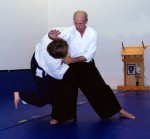I read the International Aiki Peace Week article on the USAF website recently and the following statements struck a memory chord.
“Aikido is uniquely valuable for practicing peace because attack/defense drills offer the opportunity to rouse the demons of fear and anger, and then to train oneself to receive an opponent in a kind, harmonious and grounded way. Aikido training gradually makes this reaction into our default response in times of stress, conflict, or attack.”
What are the unique aspects of Aikido training that fosters the opportunity noted above? I believe there are two essential aspects to this: one is non-competition and the other is a learning environment (uke helping nage and nage helping uke). These two principles structure the nature of our practice and how we respond during practice.
It took awhile before I experienced fear and anger during my Aikido practice. In the beginning, my mind was completely occupied with learning the basic forms – this goes here, then that there, etc. After some time, I got to a point where I had gained enough technical skill so my physical response was semi-automatic, but not quite. And during this time I was practicing with many yudansha who knew where my margin of comfort was so they would go just beyond it when in the role of either uke or nage.
So there were moments of awareness during a “beyond the margin” attack that I felt (and saw) fear arise, like a wave on the ocean, but due to the principles of our structured practice was able to observe, let go and see it disappear. This occurred with anger also. The trick for execution of technique when fear or anger arise is to not lose one’s form (execute the technique form precisely and dispassionately). In the case of fear, do not become weak and unable to move. And in the case of anger avoid the tendency for retribution.
In the inner dojo, fear and anger become the uke. Silence (the hara) becomes nage. The technique is to favor silence, connecting uke to your hara, and allow fear and anger to dissolve into that silence. An ukemi of fear and anger is a falling into dissolution.

Well written and well said.
Nice article, John. Thanks.
I’m trying to wrap my head around the concept of “dissolution” in your last paragraph. Is this related to TM?
Dissloution in the sense that the wave falls back into the ocean. The ocean doesn’t disappear. The ocean being a metaphor for transcendental conciousness – simplest form of awareness.
TM has given me that experience and the awareness to observe the comings and goings of daily experiences against the backdrop of transcendental conciousness.
Very interesting. I’d like to ask you more about this…Would you mind discussing this a bit here? If not, no worries.
Lets talk offline and see what direction you want to go.
Lets talk offline and see what direction you want to go and see if discussion is blogworthy.
Gotcha.
(John, anything you say is blogworthy! 🙂 )
Hey,
This article is featured on aikiweb…. :-0
This is a good topic in advance of Peace Week, which our school is participating in. The ocean / wave metaphor is a good metaphor for dealing with anger / conflict levels on a personal level.
I remember reading an article a few years back about a student of O-Sensei who is now an artist / environmentalist / peace activist. He likened an environmental campaign against a multinational to applying yonkyo. As in, apply pressure (in his case, publicity) to “uke’s” weak point until the desired result occurred.
Pingback: The Inner Dojo | The Martial Arts
In the inner dojo, technique is…breath? Kokyu is life, always moving, the source of our power and our peace, the movement that restores harmony.
John , As discussed , this topic is truly worthy of a larger discussion and examination. I stand ready to learn
Jorge,
I found this article by Endô Seishirô Shihan on his Cosmos web site. It discusses aikido from the perspective of Tao.
http://homepage3.nifty.com/aikido_sakudojo/Shihan_Interview_Dou144-e.html